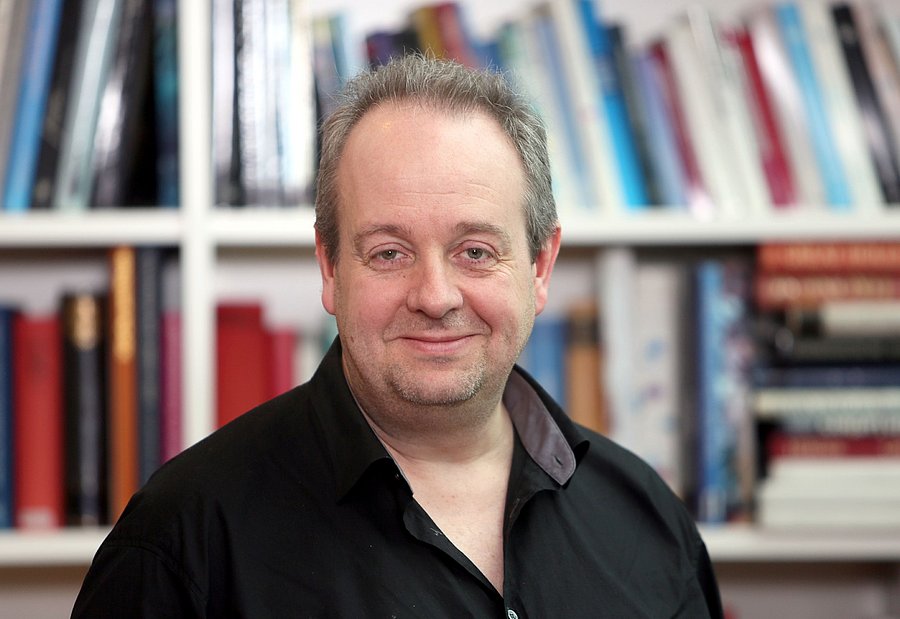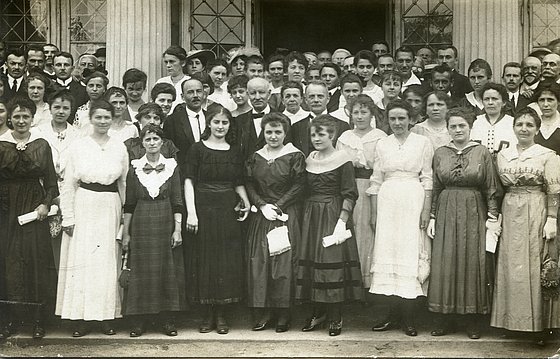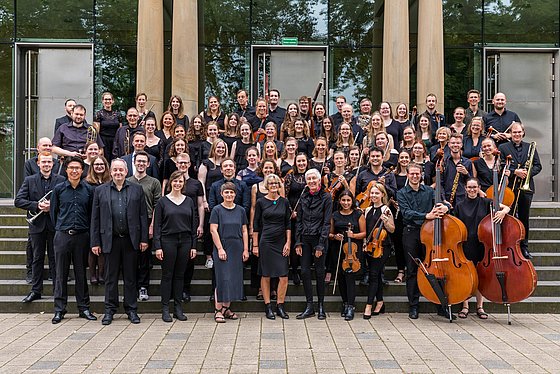
The history of choral singing
Christoph Spengler / Director of the choir and orchestra of the University of Wuppertal
Photo: Sergej Lepke
The joy of singing, the joy of community
Cherry music director Christoph Spengler on the history of choral singing
"Singing is the true mother tongue of man," says the American conductor Yehudi Menuhin. For some, singing even opens the soul. Singing together in a choir also brings people together and creates a community. Today, around 3.3 million people in Germany sing in more than 61,000 choirs. Around a third are members of the traditional "German Choral Association". Christoph Spengler, church music director and director of the Bergische Universität choir and orchestra, says: "It's a great feeling of happiness when a piece is put together like a mosaic piece by piece in a choir rehearsal and a joint 'work' is created."
But when did it all begin?
As long as there have been people, there has been singing together
The origins of singing cannot be precisely dated due to a lack of written evidence, but it is certain that there were bone flutes in the Neolithic period that encouraged people to sing and that the Greek philosopher Plato believed around 400 BC that people sang out of a need for social harmony. "It's difficult to pinpoint an exact date," says Christoph Spengler, director of church music and director of the choir and orchestra at the University of Wuppertal. "Wherever people come together, there is also singing - that has been the case since the earliest history of mankind, as far as we know. Singing together has always played a role in ritual, religious acts in particular." Singing together strengthens the sense of community and is also a very direct expression of emotions, both then and now.
Lyrics without melodies
The criteria according to which singing has developed over the course of human history is difficult to understand today, says Spengler, as ancient cultures did not know musical notation. "We do have the texts of biblical psalms, for example, but unfortunately no melodies. There were already attempts to record music in writing in ancient Egypt. The oldest known concrete musical notations of melodies are the so-called Hurrian hymns from the Bronze Age (approx. 1400 BC). The first forms of musical notation that resemble those we use today are the neumes, a graphic notation of music that developed in the 8th to 9th centuries. The first choral songs are also known to us from this period, the so-called Gregorian chant, the melodies of which we still know today." These songs were sung in unison without instrumental accompaniment. The name goes back to Pope Gregory the Great (540 - 604). The chants are still used in the Catholic liturgy today.
The beginning of polyphony and the influence of the church in choral singing
Polyphonic choral singing developed as early as the 9th century. "Here, a second voice was sung to the melody, the so-called 'cantus firmus', which ran parallel to it at a fixed interval," explains Spengler. "This form was called 'organum'. In the 9th to 11th centuries, this polyphony was further developed by composers by adding more voices to the two. The initially very simple and rigid organa developed into complex polyphonic works, which were further developed into a high art by composers such as Josquin Desprez and Giovanni Pierluigi da Palestrina in the 15th and 16th centuries."
Choral singing has always been an important part of ritual acts in various religions. However, Spengler is certain that the church was of crucial importance for the development of choral singing in Europe and says: "Church music produced the most important works of choral music of this period, especially in the Renaissance and Baroque periods."
Choral music is also dedicated to secular themes
The development of secular choral singing has run parallel to music in the church since the Middle Ages. Spengler explains: "On the one hand, there were secular songs and dance melodies, which were often popular in character and were performed by laypeople at social gatherings. On the other hand, there were courtly songs performed by professional musicians. One famous secular song collection from this period is the Carmina Burana from the 11th to 12th centuries, which formed the basis for Carl Orff's famous 20th century composition of the same name."
Male choirs dominate
The first known choirs were all-male choirs. "I think the reasons for this lie in the past," says the musician, "because even on the battlefield, people sang to strengthen their common identity, express patriotism, emphasise their love of their homeland and strengthen the military community." Singing together has always had an identity-building effect. As a social activity, it brings people together, strengthens the sense of community and promotes cohesion. "Especially after the Napoleonic Wars and the founding of the German Empire, there was a great need for a common identity. Over time, this developed into a culture of its own. In the 19th century, instruments and sheet music became more affordable and men got together to improve their singing. Men's singing became a cultural form in its own right." At the same time, of course, there were also mixed choirs to perform the great works of the time, explains Spengler, citing Mendelssohn's great oratorio "Elijah" and Brahms' Requiem. However, these choirs were less well known because some of them were put together especially for performances from trained singers.
There are probably several reasons why the choirs that emerged as a popular movement were mainly male choirs, explains the church music director. "On the one hand, of course, this has to do with the clear distribution of gender roles in the 19th century, but also with the work and community structures. In many professions, men were more organised than women. Men had better access to clubs and societies, where singing became a popular activity, including competitions and concerts. Ultimately, the authorities were also interested in promoting men's singing, as it boosted morale among the population."
Mixed choirs emerge late
For Spengler, a key reason for the late development of mixed choirs lies in social developments. "The role of women in society was changing, and in many areas of public life, gender segregation was being abolished. Women wanted to actively participate in cultural life and joined choirs that had previously been reserved for men." This also resulted in a considerable expansion of the repertoire, as the important composers wrote not only for men's choirs but also for mixed choirs, because they offered a much greater tonal variety, the expert knows. "The 20th century also saw the beginning of a strong professionalisation of choral music, choir conductors were trained and choirs were directed to a higher level accordingly. The development of a much larger, wide-ranging repertoire made people enthusiastic about choral singing, and the music could be made accessible to a much wider audience through radio, television and recordings."

Choir yesterday: Prague Choir Hlahol (1916)
Photo: public domain
Wars also stop the development of choral singing
"The world wars had a major impact on society. On the one hand, many men lost their lives, while economic instability meant that choirs found it difficult to survive financially," explains Spengler, "musical tastes also changed, jazz and later rock'n'roll became popular and interest in traditional choral music declined. In addition, active music-making was pushed back by the advent of radio and later television, because people tended to consume more." From the 1980s at the latest, traditional male choirs began to die out, a trend that continues to this day. Spengler sees the main reason for this in the fact that they stuck rigidly to the literature of the 19th century and did not move with the times. As a result, these choirs became less and less attractive to younger people.
Around 3.3 million people sing in choirs in Germany
There were several reasons for the renewed strength of the choral scene after the Second World War, says Spengler, as the social urge for cohesion and community increased again. "Values such as peace, freedom, love and hope became more important after the horrors of the Nazi era and their reappraisal and were thematised in choral songs. In my view, the emergence of choral music from the genre of popular music is particularly significant. Gospel, children's and youth choirs were formed and opened up a whole new clientele for communal singing. The German Choir Association still supports choirs today with advice, training and events such as competitions, concerts and festivals. At the latest since the advent of casting shows, singing has also become 'in' again among young people."
Singing makes you happy and strengthens the immune system
Singing in a choir boosts energy and social skills, as you have to take yourself back and always listen to the others in the choir, say choir singers. Researchers have also found that singing even strengthens the immune system because it promotes the production of the substance immunoglobulin A. Active engagement with music also causes the release of happiness hormones, so singing makes you happy. Spengler comments: "I lead a whole series of choirs, and even with the very youngest children in nurseries and primary schools, I can clearly feel the positive effects of singing together. Singing is not about who is the strongest, the aim is to 'find a sound' together, which is incredibly unifying and continues in the adult choirs. One of the nicest compliments you can get as a choirmaster is: 'I didn't really feel like coming to rehearsal today, but now I'm glad I came because I feel much better than before! '" He has this experience time and time again. "Singing is probably the most direct expression of life, it's not for nothing that the words 'voice' and 'mood' are so closely related. This is where people can express themselves without filters, find sound, connect with others and feel a special sense of community."
An English study of people over 40 shows that people who play a musical instrument or sing frequently have a better working memory and can therefore also prevent dementia. Music can therefore keep the brain healthy and more efficient, improve memory performance and even reduce stress.

Choir today: Choir and orchestra of the University of Wuppertal (2022)
Photo: University of Wuppertal
The intense flirtation with the choir
When asked: "What makes a successful choir?", Spengler answers spontaneously: "The joy of singing! The joy of community! In the end, it's not just the choice of literature that plays the most important role, but the atmosphere in which choir rehearsals take place. For me, a choir rehearsal is so much more than just learning the right notes of a piece! When I train choir conductors myself, I like to say: 'A choir rehearsal is 80% flirting with the choir'. A choir conductor can be technically excellent, but if he or she lacks the empathy to respond to the people in the choir, he or she will not be successful. As choirmasters, we must always succeed in making our enthusiasm for the music, but also for this wonderful sound structure that a choir represents, tangible. What a wonderful, lively, multi-layered and changeable instrument a choir is! And how marvellous is the experience when we succeed in bringing a written musical idea to life? For me, there is hardly anything better!"
Even though Christoph Spengler has already realised many works with his choirs, as a conductor he has another dream that he still wants to fulfil: "One day I would like to conduct Gustav Mahler's famous Resurrection Symphony."
Uwe Blass
Christoph Spengler studied church music in Düsseldorf. He took over the direction of the university choir in 2007 and the orchestra in 2011. In 2016, the rectorate awarded him the University of Wuppertal's Medal of Honour. In 2017, he was appointed church music director by the Protestant Church in the Rhineland.
